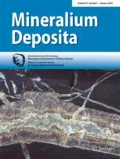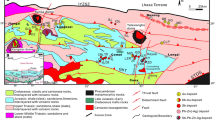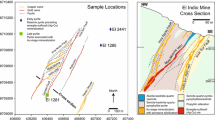Abstract
The genesis of mineralized systems across the Mountain Freegold area, in the Dawson Range Cu–Au ± Mo Belt of the Tintina Au province was constrained using Pb and stable isotope compositions and Ar–Ar and Re–Os geochronology. Pb isotope compositions of sulfides span a wide compositional range (206Pb/204Pb, 18.669–19.861; 208Pb/204Pb, 38.400–39.238) that overlaps the compositions of the spatially associated igneous rocks, thus indicating a magmatic origin for Pb and probably the other metals. Sulfur isotopic compositions of sulfide minerals are broadly similar and their δ34S (Vienna-Canyon Diablo Troilite (V-CDT)) values range from −1.4 to 3.6 ‰ consistent with the magmatic range, with the exception of stibnite from a Au–Sb–quartz vein, which has δ34S values between −8.1 and −3.1 ‰. The δ34S values of sulfates coexisting with sulfide are between 11.2 and 14.2 ‰; whereas, those from the weathering zone range from 3.7 to 4.3 ‰, indicating supergene sulfates derived from oxidation of hypogene sulfides. The δ13C (Vienna Peedee Belemnite (VPDB)) values of carbonate range from −4.9 to 1.1 ‰ and are higher than magmatic values. The δ18O (V-SMOW) values of magmatic quartz phenocrysts and magmatic least-altered rocks vary between 6.2 and 10.1 ‰ and between 5.0 and 10.1 ‰, respectively, whereas altered magmatic rocks and hydrothermal minerals (quartz and magnetite) are relatively 18O-depleted (4.2 to 7.9 ‰ and −6.3 to 1.5 ‰, respectively). Hydrogen isotope compositions of both least-altered and altered igneous rock samples are D-depleted (from −133 to −161 ‰ Vienna-Standard Mean Ocean Water (V-SMOW)), consistent with differential magma degassing and/or post-crystallization exchange between the rocks and meteoric ground water. Zircon from a chlorite-altered dike has a U–Pb crystallization age of 108.7 ± 0.4 Ma; whereas, the same sample yielded a whole-rock Ar–Ar plateau age of 76.25 ± 0.53 Ma. Likewise, molybdenite Re–Os model ages range from 75.8 to 78.2 Ma, indicating the mineralizing events are genetically related to Late Cretaceous volcano-plutonic intrusions in the area. The molybdenite Re–Os ages difference between the nearby Nucleus (75.9 ± 0.3 to 76.2 ± 0.3 Ma) and Revenue (77.9 ± 0.3 to 78.2 ± 0.3 Ma) mineral occurrences suggests an episodic mineralized system with two pulses of hydrothermal fluids separated by at least 2 Ma. This, in combination with geological features suggest the Nucleus deposit represents the apical and younger portion of the Revenue–Nucleus magmatic-hydrothermal system and may suggest an evolution from the porphyry to the epithermal environments.










Similar content being viewed by others
References
Aleinikoff JN, Lang Farmer G, Rye RO, Nokleberg WJ (2000) Isotopic evidence for the sources of Cretaceous and Tertiary granitic rocks, east-central Alaska: implications for the tectonic evolution of the Yukon–Tanana Terrane. Can J Earth Sci 37:945–956
Bachinski DJ (1969) Bond strength and sulfur isotope fractionation in coexisting sulfides. Econ Geol 64:56–65
Bacon CR, Adami LH, Lanphere MA (1989) Direct evidence for the origin of low-18O silicic magmas: quenched samples of a magma chamber’s partially-fused granitoid walls, Crater Lake, Oregon. Earth Planet Sci Lett 96:199–208
Bindeman IN, Valley JW (2000) Formation of low-δ18O rhyolites after caldera collapse at Yellowstone, Wyoming, USA. Geology 28:719–722
Bineli Betsi T, Bennett V (2010) New U–Pb age constraints at Freegold Mountain: Evidence for multiple phases of polymetallic mid- to Late Cretaceous mineralization. In: MacFarlane KE, Weston LH, Blackburn LR (eds) Yukon Exploration and Geology 2009, Yukon Geological Survey, pp 57–84
Bineli Betsi T, Lentz D (2009) Petrogenesis of dykes related to Cu–Au & base-metal Au-Ag occurrences, Mt. Freegold area, Dawson Range, Yukon Territory, Canada. In: Lentz DR, Thorne KG, Beal K-L (eds) Proceedings of the 24th IAGS, Fredericton, Canada, pp 115–118
Bineli Betsi T, Lentz D (2010) The nature of quartz eyes hosted by dykes associated with Au–Bi–As–Cu, Mo–Cu, and Base-metal–Au–Ag mineral occurrences in the Mountain Freegold region (Dawson Range), Yukon, Canada. J Geosci 55:347–368
Bineli Betsi T, Lentz D (2011) Petrochemistry of subvolcanic dyke swarms associated with the Golden Revenue Au–Cu and the Stoddart Mo–Cu ± W mineralizations (Dawson Range, Yukon Territory, Canada) and implications for ore genesis. Ore Geol Rev 39:134–163
Bineli Betsi T, Lentz D (2012) Chemical composition of rock-forming minerals in granitoids associated with Au–Bi–Cu, Cu–Mo, and Au–Ag mineralization at the Freegold Mountain, Yukon, Canada: magmatic and hydrothermal fluid chemistry and petrogenetic implications. Int Geol Rev. doi:10.1080/00206814.2012.731767
Bineli Betsi T, Lentz D, McInnes B, Evans N (2012) Emplacement ages and exhumation rates for intrusion-hosted Cu–Mo–Sb–Au mineral systems at freegold mountain (Yukon, Canada): assessment from U–Pb, Ar–Ar, and (U–Th)/He geochronometers. Can J Earth Sci 49:653–670. doi:10.1139/e2012-009
Burnham CW (1979) Magma and hydrothermal fluids. In: Barnes HL (ed) Geochemistry of hydrothermal ore deposits, 2nd edn. Wiley, New York, pp 71–136
Carlson GG (1987) Geology of Mount Nansen (115-1/3) and Stoddart Creek (115-1/6) map areas Dawson Range, Central Yukon: Indian and Northern affairs Canada, Northern affairs, Yukon Region, Open File 1987-2, 181 pp
Clayton RN, Mayeda TK (1963) The use of bromine pentafluoride in the extraction of oxygen from oxides and silicates for isotopic analysis. Geochim Cosmochim Acta 27:43–52
Colpron MN, Nelson JL (2011) A digital atlas of terranes for the Northern Cordillera. BC GeoFile 2011
Colpron MN, Nelson JL, Murphy DC (2006) A tectonostratigraphic framework for the Pericratonic terranes of the northern Canadian Cordillera. In: Colpron M, Nelson JL (eds) Paleozoic evolution and metallogeny of Pericratonic Terrranes at the ancient pacific margin of North America, Canadian and Alaskan Cordillera. Geol Assoc Can SP 45, pp 1–23
De Hoog JCM, Taylor Bruce E, Van Bergen MJ (2009) Hydrogen-isotope systematics in degassing basaltic magma and application to Indonesian arc basalts. Chem Geol 266:256–266
Deyell CL, Rye RO, Landis GP, Bissig T (2005) Alunite and the role of magmatic fluids in the Tambo high-sulfidation deposit, El Indio–Pascua belt, Chile. Chem Geol 215:185–218
Einaudi MT, Hedenquist JW, Innan E (2003) Sulfidation state of fluids in active and extinct hydrothermal systems: transitions from porphyry to epithermal environments. Soc Econ Geol Spec Publ 10:285–314
Field CW, Lombardi G (1972) Sulfur isotopic evidence for the supergene origin of alunite deposits, Tolfa district, Italy. Miner Deposita 7:113–125
Gerstenberger H, Haase G (1997) A highly effective emitter substance for mass spectrometric Pb isotope ratio determinations. Chem Geol 136:309–312
Godwin CI (1976) Casino. In: Brown AS (ed) Porphyry deposits of the Canadian Cordillera. CIM, special volume 15, pp 344–354
Gordey SP, Makepeace AJ (2000) Bedrock geology, Yukon Territory. Geological Survey of Canada, Open File 3754, and Exploration and Geological Services Division, Yukon Region, Indian and Northern Affairs Canada, Open File 2001-1, 1:1 000 000 scale
Harris AC, Dunlap WJ, Reiners PW, Allen CM, Cooke DR, White NC, Campbell IH, Golding SD (2008) Multimillion year thermal history of a porphyry copper deposit: application of U–Pb, 40Ar/39Ar and (U–Th)/He chronometers, Bajo de la Alumbrera copper–gold deposit, Argentina. Miner Deposita 43:295–314
Hart CJR (2007) Reduced intrusion-related gold systems. In Goodfellow WD (ed) Mineral deposits of Canada: A synthesis of major deposit types, District Metallogeny, the evolution of geological provinces, and exploration methods. Geological Association of Canada, Mineral Deposits Division, Special Publication No. 5, pp 95–112
Hefferman RS, Mortensen JK, Gabites JE, Sterenberg V (2005) Lead isotope signatures of Tintina Gold Province intrusions and associated mineral deposits from southeastern Yukon and southwestern Northwest Territories: Implications for exploration in the southeastern Tintina Gold Province. In: Emond DS, Lewis LL, and Bradshaw GD (eds) Yukon Exploration and Geology 2004, Yukon Geological Survey, pp 121–128
Heinrich CA (2005) The physical and chemical evolution of low-salinity magmatic fluids at the porphyry to epithermal transition: a thermodynamic study. Miner Deposita 39:864–889
Holland HD, Malinin SD (1979) Oxygen and hydrogen isotope relationships in hydrothermal mineral deposits. In: Barnes HL (ed) Geochemistry of hydrothermal ore deposits, 2nd edn. Wiley, New York, pp 461–508
Javoy M (1997) Stable isotope and geothermometry. J Geol Soc 133:609–636
Jensen ML, Ashley RP, Albers JP (1971) Primary and secondary sulfates at Goldfield, Nevada. Econ Geol 66:618–626
Johnston ST (1995) Geological compilation with interpretation from geophysical surveys of the northern Dawson Range, central Yukon (115-J/9 and 115- J/10, 115-J/12, 1: 100 000-scale map). Exploration and Geological Services Division, Yukon Region, Indian and Northern Affairs Canada, Open File 1995-2 (G), 171 pp
Koppers AP (2002) ArArCALC – software for 40Ar/39Ar age calculations. Comput Geosci 28:605–619
Kyser TK (1986) Stable isotope variations in the mantle. In: Valley JW, Taylor HP Jr, O’neil JR (eds) Stable isotopes in high temperature geological processes. Mineralogical Society of America Reviews in Mineralogy 16: 141–164
Lang JR, Baker T (2001) Intrusion-related gold systems: the present level of understanding. Miner Deposita 36:477–489
Longerich HP (1995) The analysis of pressed pellets of geological samples using wavelength dispersive X-ray fluorescence spectrometry. X-Ray Spectrom 24:123–136
Ludwig KR (2003) Isoplot 3.09 A Geochronological Toolkit for Microsoft Excel. Berkeley Geochronology Center, Special Publication No. 4, 71 pp
Maloof TL, Baker T, Thompson JF (2001) The Dublin Gulch intrusion-hosted gold deposit. Tombstone Plutonic suite, Yukon Territory, Canada. Miner Deposita 36:583–593
Matsuhisa Y, Goldsmith JR, Clayton RN (1979) Oxygen isotope fractionation in the system quartz-albite-anorthite-water. Geochim Cosmochim Acta 43:1131–1140
McCausland PJA, Symons DTA, Hart CJR, Blackburn WH (2001) Paleomagnetic study of the Late Cretaceous Seymour Creek stock, Yukon: Minimal geotectonic motion of the Yukon-Tanana Terrane. In: Emond DS, Weston LH (eds) Yukon Exploration and Geology 2000, Exploration and Geological Services Division, Yukon Region, Indian and Northern Affairs Canada, pp 207–216
McInnes BIA, Goodfellow WD, Crocket JH, McNutt RH (1988) Geology, geochemistry and geochronology of subvolcanic intrusions associated with gold deposits at Freegold Mountain, Dawson Range, Yukon. Geological Survey of Canada, Current Research 88-1E, pp 137–151
Mortensen JK, Appel V, Hart JR (2003) Geological and U–Pb constraints on base and precious metal vein systems in the Mount Nansen area, eastern Dawson Range, Yukon. Yukon Exploration and Geology 2002, pp 165–174
Muntean JL, Einaudi M (2001) Porphyry-epithermal transition: Maricunga Belt, Northern Chile. Econ Geol 96:743–772
Ohmoto H, Rye RO (1979) Isotopes of sulfur and carbon. In: Barnes HL (ed) Geochemistry of hydrothermal ore deposits, 2nd edn. Wiley, New York, pp 509–567
Payne JG, Gonzalez RA, Akhurst K, Sisson WG (1987) Geology of Colorado Creek (115-J/10), Selwyn River (115-J/9), and Prospector Mountain (115-1/5) map areas, western Dawson Range, west-central Yukon: Exploration and Geological Services Division, Indian and Northern Affairs Canada, Yukon Region, Open File 1987-3, 141 p
Phillips GN (1986) Geology and alteration in the Golden Mile, Kalgoorlie. Econ Geol 91:779–808
Pin C, Briot D, Bassin C, Poitrasson F (1994) Concomitant separation of strontium and samarium–neodymium for isotopic analysis in silicate samples, based on specific extraction chromatography. Anal Chim Acta 298:209–217
Pineau F, Shilobreeva S, Kadik A, Javoy M (1998) Water solubility and D/H fractionation in the system basaltic andesite—H2O at 1250 °C and between 0.5 and 3 kbars. Chem Geol 147:173–184
Pudack C, Halter WE, Heinrich CA, Pettke T (2009) Evolution of magmatic vapor to gold-rich epithermal liquid: the porphyry to epithermal transition at Nevados de Famatina, northwest Argentina. Econ Geol 104:449–477
Quin SP, Mercer BJ (2008) The Minto copper-gold deposit - IOCG or what? Geological Association of Canada, Québec 2008, Abstracts, vol. 33, p 140
Renne PR, Swisher CC, Deino AL, Karner DB, Owens T, DePaolo DJ (1998) Intercalibration of standards, absolute ages and uncertainties in 40Ar/39Ar dating. Chem Geol 145(1–2):117–152
Ripperdan RL (2001) Stratigraphic variation in marine carbonate carbon isotope ratios. In: Valley JW, Cole DR (eds.) Stable isotope geochemistry: reviews in mineral and geochem 43, pp 637–662
Rye RO (2005) A review of the stable-isotope geochemistry of sulfate minerals in selected igneous environments and related hydrothermal systems. Chem Geol 215:5–36
Sakai H (1968) Isotopic properties of sulfur compounds in hydrothermal processes. Geochem J 2:29–49
Sakai H, Gunnlaugsson E, Tomasson J, Rousse JE (1980) Sulfur isotope systematic in Icelandic geothermal systems and influence of seawater circulation at Reykjanes. Geochim Cosmochim Acta 44:1223–1231
Seal RR II (2006) Sulfur isotope geochemistry of sulfide minerals. Rev Mineral Geochem 61:633–677
Selby D, Creaser RA (2001) Late and mid-Cretaceous mineralization in the northern Canadian Cordillera: constraints from Re–Os molybdenite dates. Econ Geol 96:1461–1467
Selby D, Creaser RA (2004) Macroscale NTIMS and microscale LA-MC-ICP-MS Re–Os isotopic analysis of molybdenite: Testing spatial restrictions for reliable Re–Os age determinations, and implications for the decoupling of Re and Os within molybdenite. Geochim Cosmochim Acta 68:3897–3908
Selby D, Creaser RA, Nesbit EB (1999) Major and trace element compositions and Sr-Nd-Pb systematics of crystalline rocks from the Dawson Range, Yukon, Canada. Can J Earth Sci 36:1463–1481
Selby D, Creaser RA, Hart CJR, Rombach CS, Thompson JFH, Smith MT, Bakke AA, Goldfarb RJ (2002) Absolute timing of sulfide and gold mineralization: a comparison of Re–Os molybdenite and Ar–Ar mica methods from the Tintina Gold Belt, Alaska. Geology 30(9):791–794
Sillitoe RH, Hedenquist JW (2003) Linkages between volcanotectonic settings, ore fluid compositions, and epithermal precious metal deposits. Soc Econ Geol Spec Publ 10:315–343
Sinclair WD, Cathro RJ, Jensen EM (1981) The Cash porphyry copper-molybdenum deposit, Dawson Range, Yukon Territory. Can Min Metall Bull 74(832):1–10
Smuk KA (1999) Metallogeny of epithermal gold and base metal veins of the southern Dawson Range, Yukon: Unpublished MSc. thesis, McGill University, Montreal, Quebec, 155 pp
Smuk KA, Williams-Jones AE, Francis D (1997) The Carmacks hydrothermal event: An alteration study in the southern Dawson Range. In: Yukon Geology 1996, Exploration and Geological Services Division, Yukon Region, Indian and Northern Affairs, Canada, pp 92–106
Tafti R, Mortensen JK (2004) Early Jurassic porphyry(?) copper (-gold) deposits at Minto and Williams Creek, Carmacks Copper Belt, western Yukon. In: Emond DS, Lewis LL (eds.) Yukon Exploration and Geology 2003, Yukon Geological Survey, pp 289–303
Taylor BE (1986) Magmatic volatiles: Isotopic variation of C, H, and S stable isotopes in high temperature geological processes. In: Valley JW, Taylor HP, O’Neil JR (eds) Rev Mineral 16, pp 185–225
Taylor HP Jr. (1974) Oxygen and hydrogen isotope evidence for large-scale circulation and interaction between ground waters and igneous intrusions, with particular reference to the San juan volcanic field, Colorado. In: Hoffman AW, Gileti BJ, Yoder HSJr., Yund RA (eds) Geochemical transport and Kinematics: Washington, DC, Carnegie Institution Wash, pp 299–324
Taylor HP Jr, Sheppard SMF (1986) Igneous Rocks I: Processes of isotopic fractionation and isotope systematic. In: Valley JW, Taylor HP, O’Neil JR (eds) Stable isotopes in high temperature geological processes. Rev Miner 16, pp 227–269
Taylor HP Jr et al (1979) Oxygen and hydrogen isotope relationships in hydrothermal mineral deposits. In: Barness HL (ed) Geochemistry of hydrothermal ore deposits. Wiley, New York, pp 236–277
Taylor BE, Eichelberger JC, Westrich HR (1983) Hydrogen isotopic evidence of rhyolitic magma degassing during shallow intrusion and eruption. Nature 306(8):541–545
Tempelman-Kluit DJ (1974) Reconnaissance geology of Aishihik Lake, Snag and part of Stewart River map-areas, west-central Yukon (115A, 115F, 115G and 115K). Geol Surv Can 73:41–97
Tempelman-Kluit DJ (1984) Geology, Laberge (105E) and Carmacks (105I), Yukon Territory: Geological Survey of Canada, Open File 1101, maps with legends, 1:250 000 scale
Thompson JFH, Sillitoe RH, Baker T, Lang JR, Mortensen JK (1999) Intrusion-related gold deposits associated with tungsten-tin provinces. Miner Deposita 34:323–334
Todt W, Cliff RA, Hanser A, Hofmann AW (1996) Evaluation of a 202Pb–205Pb double spike for high-precision lead isotope analysis. In: Basu A, Hart SR (eds) Earth processes, reading the isotopic code: Am Geoph, Un Geoph Mon 95, pp 429–437
Tosdal RM, Wooden JL, Bouse R (1999) Lead isotopes, ore deposits, and metallogenic terranes. In: Lambert DD, Ruiz J (eds) Application of radiogenic isotopes to ore deposit research and exploration. Rev Econ Geol, pp 1–25
Vigneresse JL (2007) The role of discontinuous magma inputs in felsic magma and ore generation. Ore Geol Rev 30:181–216
Yang XM, Lentz DR (2010) Sulfur isotopic systematic of granitoids from southwestern New Brunswick, Canada: implications for magmatic-hydrothermal processes, redox conditions, and gold mineralization. Miner Deposita 45:795–816
Zartman RE, Doe BR (1981) Plumbotectonics, the model. Tectonophysics 75:135–162
Zimbelman DR, Rye RO, Breit G (2005) Origin of secondary sulfate minerals in active andesitic stratovolcanoes. Chem Geol 215:37–60
Acknowledgments
The authors are grateful to the Yukon Geological Survey (YGS) for the funding allocated to this study. They also acknowledge NFR, owner of many of the Freegold Mountain properties for allowing access to the properties and for substantial logistic support. Additional funding was from a NSERC Discovery grant to DL. Michèle Senn (Department of Mineralogy, University of Geneva) is thanked for technical help in the preparation of samples for Pb isotope analyses. We are also grateful to the two anonymous reviewers, as well as Editor Georges Beaudoin for their comments and suggestions, which notably improved this manuscript.
Author information
Authors and Affiliations
Corresponding author
Additional information
Editorial handling: G. Beaudoin
Appendices
Appendix 1
Appendix 2
Rights and permissions
About this article
Cite this article
Bineli Betsi, T., Lentz, D., Chiaradia, M. et al. Genesis of the Au–Bi–Cu–As, Cu–Mo ± W, and base–metal Au–Ag mineralization at the Mountain Freegold (Yukon, Canada): constraints from Ar–Ar and Re–Os geochronology and Pb and stable isotope compositions. Miner Deposita 48, 991–1017 (2013). https://doi.org/10.1007/s00126-013-0465-4
Received:
Accepted:
Published:
Issue Date:
DOI: https://doi.org/10.1007/s00126-013-0465-4




